In the studio with Michael Carney
In a Kent Town laneway, Michael Carney is creating colourful anti-landscapes that shake up the natural order.

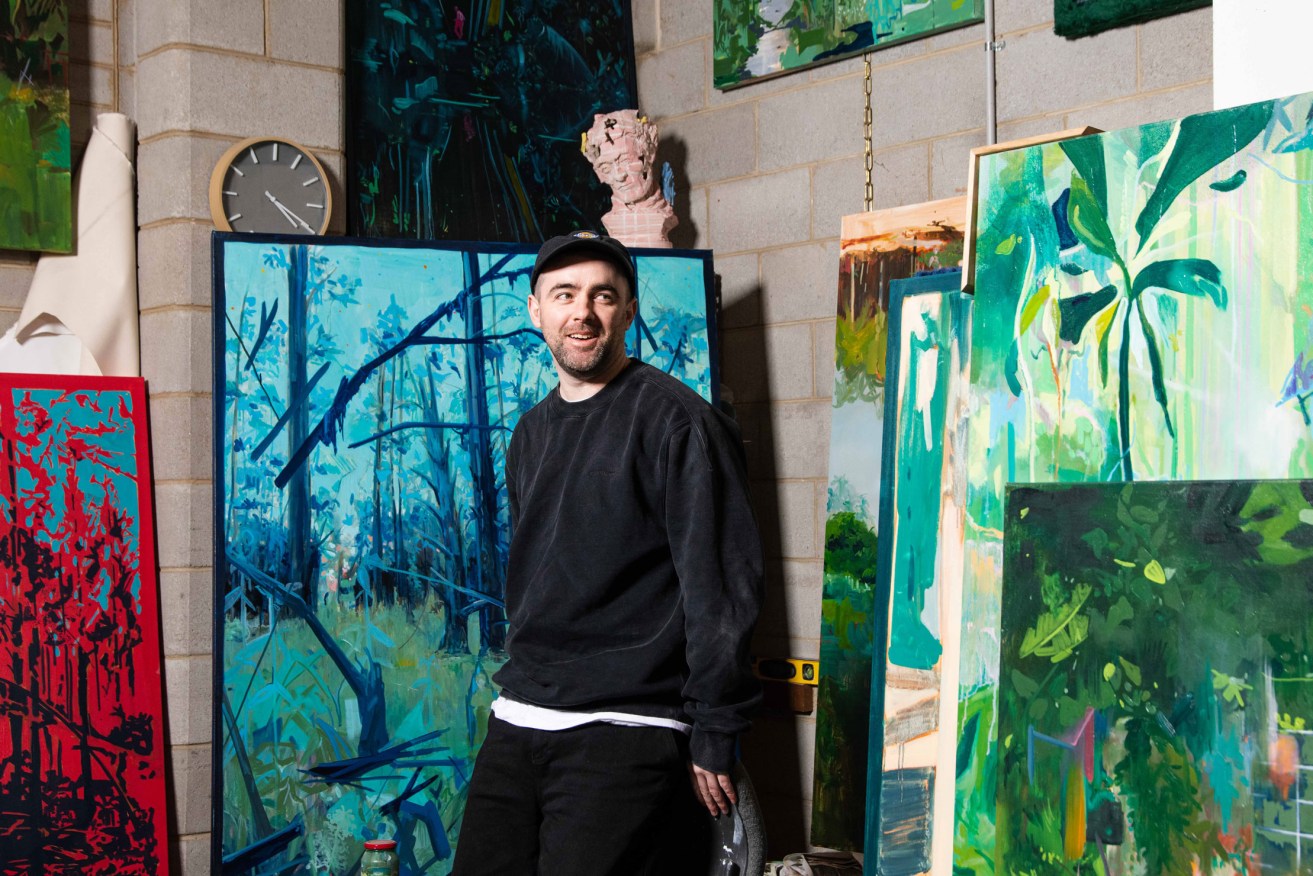
Michael Carney in his warehouse studio space in Kent Town. Photo: Jack Fenby / InReview
The back lanes of Kent Town are an often drab rabbit warren of carparks, warehouses, and yet more car parks. But sometimes you can walk through a roller door and enter another world of colour and chaos prising its way through the concrete and corrugated iron.
This particular warehouse contains an eye-popping mix of materials and projects, home to a group of artists including Dave Court and performance art collective The Bait Fridge. In the back corner, crafting an alternate world in every canvas, is Michael Carney.
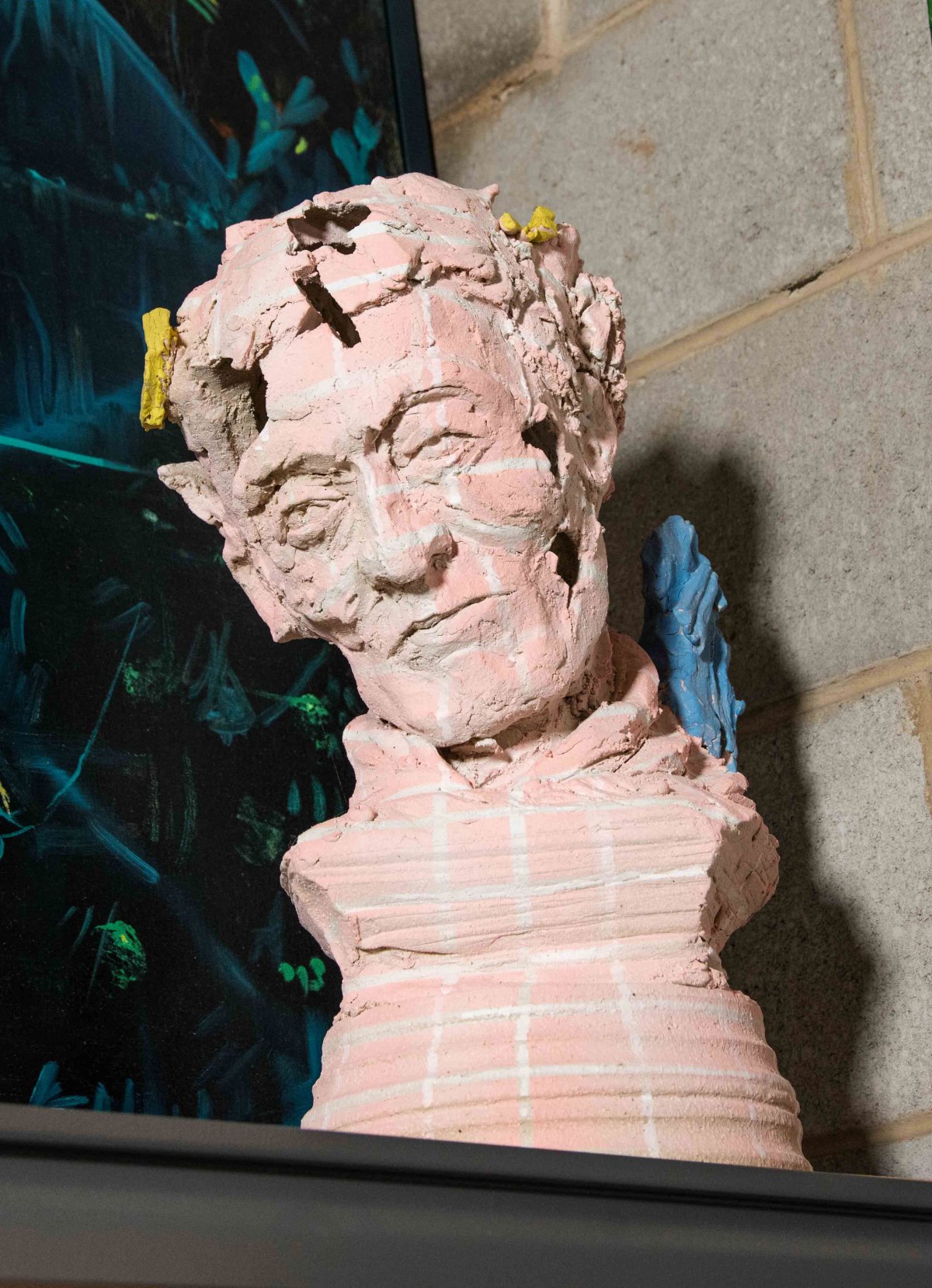
A pink bust looks down on Michael Carney’s workstation. Photo: Jack Fenby
Carney sits at a little desk surrounded by large paintings stacked one on top of the other, and ceramic works from when he was based at the JamFactory. These recognisable, almost classical forms – a vase, a bust – appear frozen in a state of decay or eruption.
“I was working on a kind of apocalyptic transition; having the statue be blown apart,” he explains of an older work, a pink bust riven with cracks and pock marks that looks down at his workstation. “Clay and broken bits of pottery often relate to fallen civilisations, so it’s pretty easy to work down that path.
“Painting and ceramics are definitely the bosses of the situation here but I’m trying to be a proper artist and use as many different tools as I can,” Carney jokes.
“Now it’s kind of after the apocalypse,” he says, looking to the canvases. From a distance they might resemble conventional landscapes – lush jungle scenes, dripping with deep greens and midnight blues. But there’s a disjointed quality to the compositions, the plant-life jostling for space in the frame with out-of-place figures and architectural shapes.
These scenes don’t exist in real life, but are pulled together from a broad range of sources and inspiration, from the documentary Over Your Cities Grass Will Grow, about German industrial artist Anselm Kiefer, to mashed-up digital collages of found images (Carney was a graphic designer before pivoting to painting).
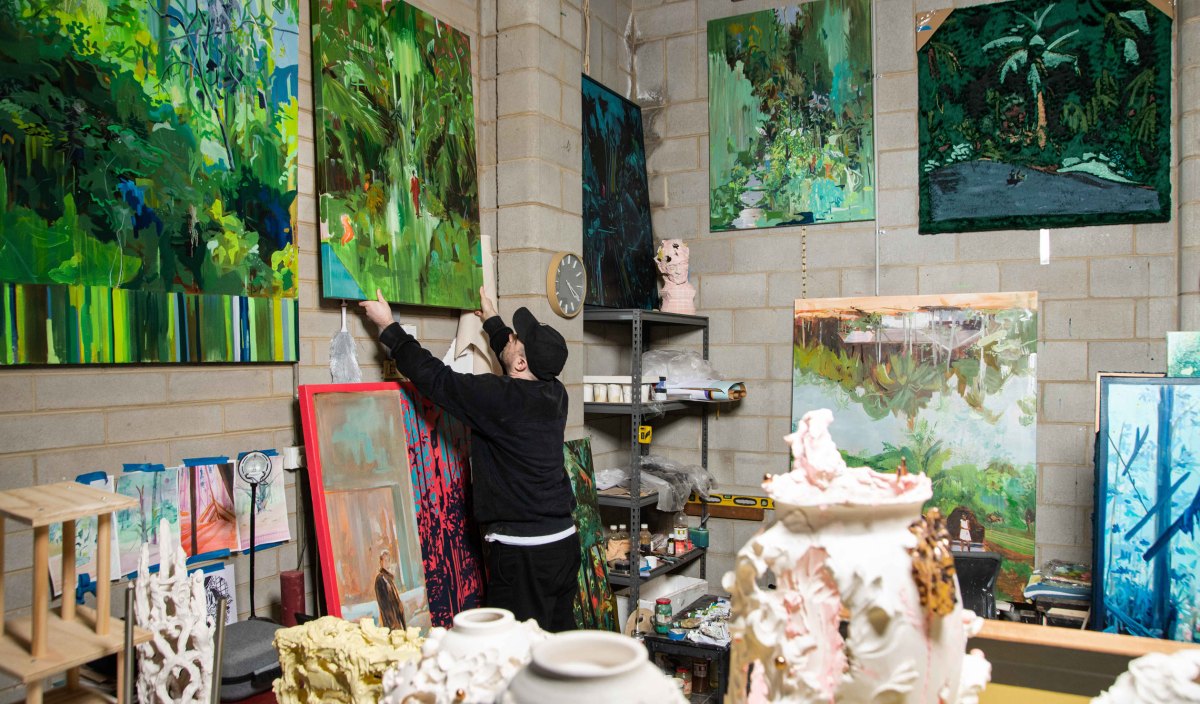
Look closely, and it’s clear Carney’s paintings aren’t traditional landscapes. Photo: Jack Fenby
“I’m trying to make sure that I’m not going down the landscape path,” he says. “There’s so many different things that go into each painting – all the things I’m interested in, aggregated and spat out.
“Most landscape paintings are about your relationship with nature, being out there in the forest, plein air painting. And that’s not really me; these things come from everywhere, Photoshop, ripped-up bits of paper, VR games, movies.
“This one was up in Blackwood – I took photos and then ran into the bush amongst the thicket and waited for the timer to go off even though people can’t see me. It kind of jumps around. Some are just purely my relationship with digital or the second-hand version of nature, how we think about it. When I started this one,” he says, pointing to another, “I was in a VR game in a forest building treehouses.”
In one piece the orange silhouette of a figure floats among the green, based on the outline of Gregory Peck in the film North By Northwest. In another, a snapshot of a family appears out of place in the foreground.
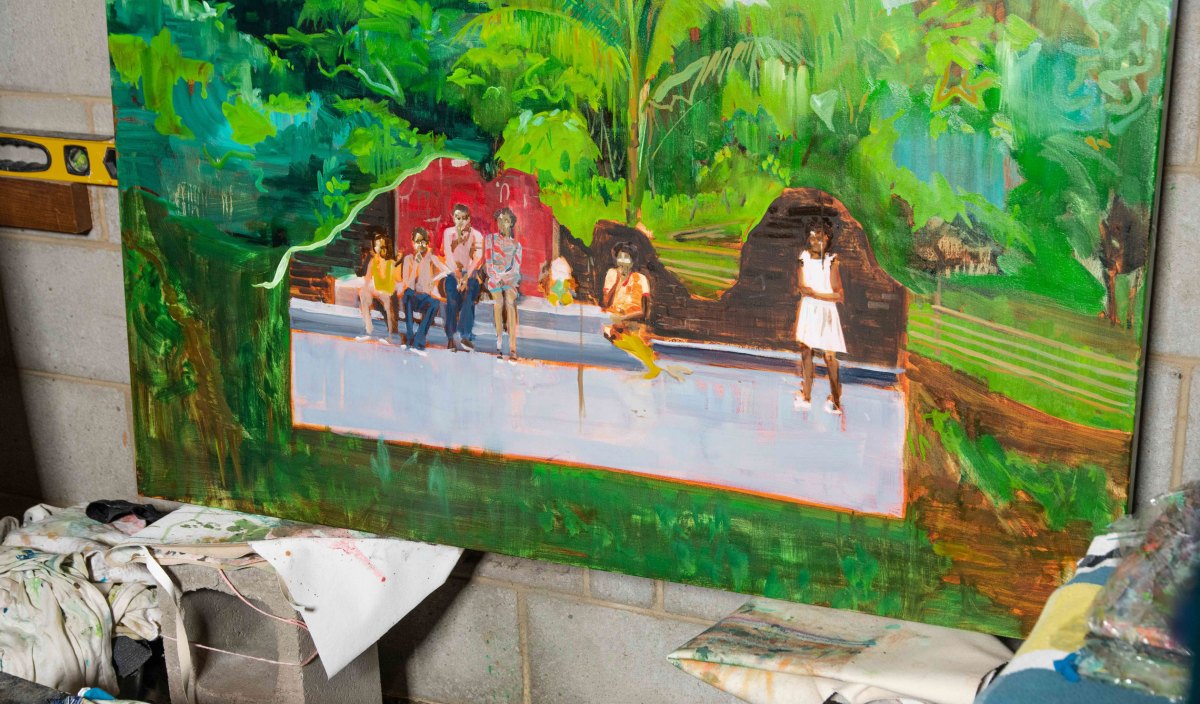
A family appears in the foreground of one of Michael Carney’s paintings. Photo: Jack Fenby
“I was trying to confuse the era a bit. Just having different people, their clothes might be a different era, a different cut, it injects a bit of unease into it when you’re trying to piece together the painting. Okay, what era is this? What country is this?”
At the moment this body of work, tentatively titled Biophobia, is still revealing itself to Carney. There are a few experiments he still isn’t sure about, from painting on canvases of fake-coloured fur to a walk-through digital gallery of his work he has created for a VR headset (“I try not to be a control freak, and just let them do what they want to do,” he says).
Carney hopes that the tension between the familiar and the uncanny, the natural order and digital disruption, will let the viewer find their own way through the undergrowth.
“That’s a huge thing I think about when I’m making. How are people going to see it? How will they navigate it? Not so much how I was feeling when I was making it, but give them free rein, a lot of options.
“If something is too literal, it gets painted out of the painting. Because I want people to have completely different experiences to the person next to them.”
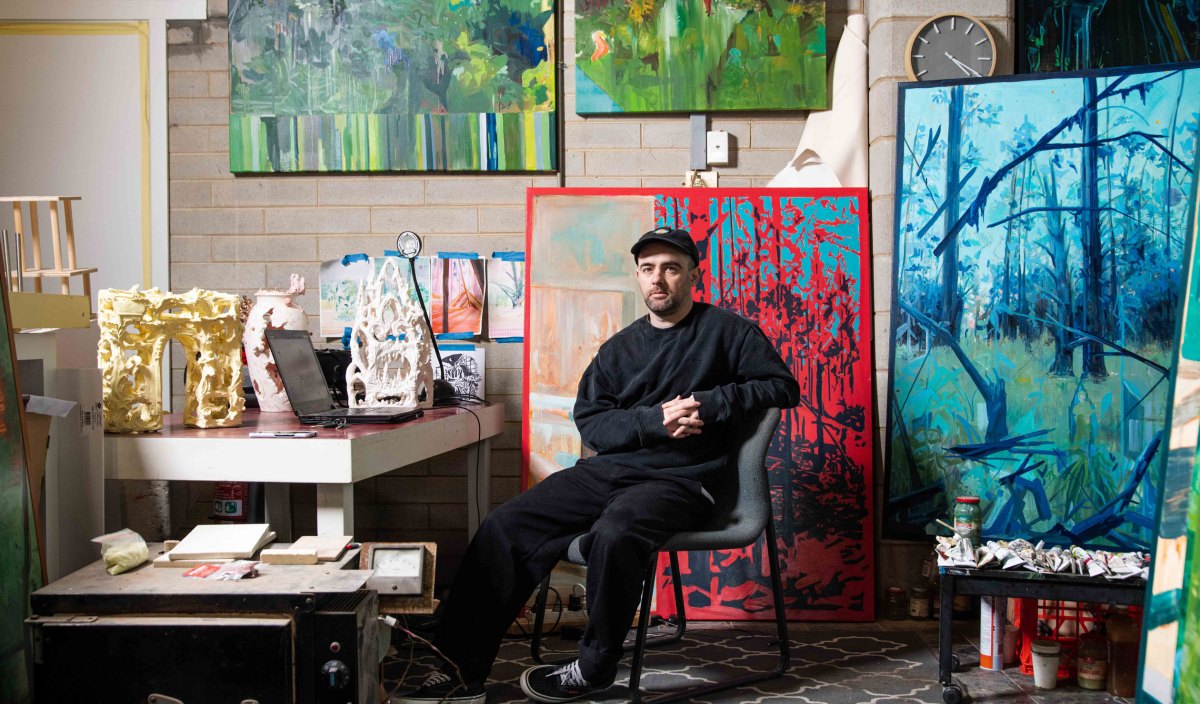
The artist at his desk, surrounded by large paintings and ceramic works that appear frozen in a state of decay or eruption. Photo: Jack Fenby
Michael Carney was awarded a mentorship through the 2022 Guildhouse Catapult program and will use it to work with multidisciplinary artist Mark Valenzuela to learn new building and firing techniques to create larger-scale work and installations while exploring experimental approaches to exhibiting. Read more about Carney’s art practice on his website.
In the Studio is a regular series presented by InReview in partnership with not-for-profit organisation Guildhouse. The series shares interesting stories about South Australian visual artists, craftspeople and designers, offering insight into their artistic practices and a behind-the-scenes look at their studios or work spaces. Read our previous stories here.




